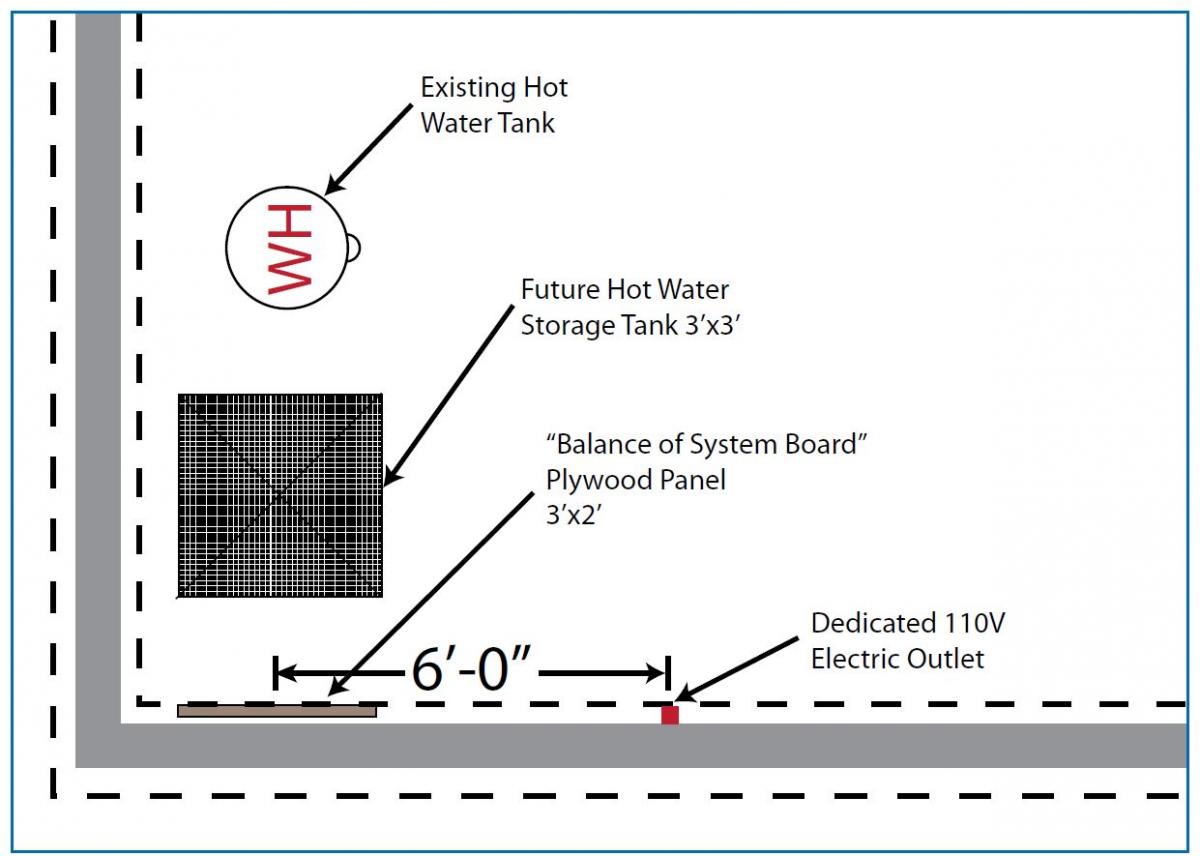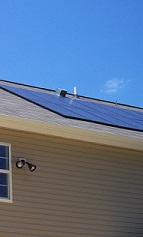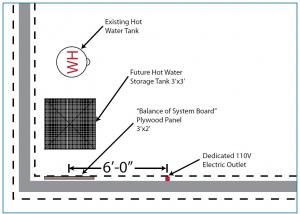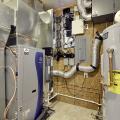Scope
Include adequate utility room space for a solar hot water storage tank on a floor plan of the utility room when building a Renewable Energy Ready Home (RERH). Space requirements for solar water heating and photovoltaic system components should be taken into account early in the house design process.
See the Compliance Tab for links to related codes and standards and voluntary federal energy-efficiency program requirements.
Description
A renewable energy-ready home (RERH) is one that is built with the wiring and plumbing conduit and other components in place to facilitate the future installation of solar photovoltaic panels and/or solar water heating panels. Some energy-efficiency programs, like the U.S. Department of Energy’s DOE Zero Energy Ready Home Program, require homes to be renewable-energy ready.
When constructing a home to be renewable energy ready, the solar hot water storage tank is one of two major components of a solar water heating system that are installed in the utility room. Typically, a domestic hot water solar system with an 80- to 120-gallon storage tank will require approximately 9 square feet of floor space with 7 feet of total vertical clearance. The builder should designate a space no less than 3 ft x 3 ft wide by 7 ft high and locate it near the home’s hot water heater so that any pipe running between the two components can be kept to a minimum. Since the pipe run or pipe chase of the solar hot water system will terminate directly above this space, it should be free of all electrical wiring and service panels as well as windows. Labeling this area as an RERH component is recommended, as is recording its location on a plumbing riser diagram. Once installed, the solar hot water storage tank should become the primary source of hot water, whereas the home’s existing water heater should serve as a backup heating source.
The second major component installed in the utility room is the plywood panel for mounting system components including the pumping package. This panel is described in the guide Mounting Surface for Pumps and Gauges. Additional details on all of the solar water heating system components and requirements can be found in the EPA’s Renewable Energy Ready Home (RERH) Solar Water Heating Specification, Checklist and Guide.
How to Designate Utility Room Space for the Hot Water Tank
- To meet the requirements of the DOE Zero Energy Ready Home program, designate a dedicated space for the future solar hot water storage tank, 3 ft wide, 3 ft deep, and 7 ft high. Locate the space adjacent to the home’s hot water heater.
- Label the space by placing a 10 in. x 6 in. label or sign on the wall where the water tank will be located that reads “Renewable Energy Ready Home – Future Hot Water Storage Tank.”
- Record the tank location on the utility room floor plan to be provided to the homeowner. See Figure 1.
- Record the tank location on a plumbing riser diagram.
- This dedicated tank space should meet floor load requirements calculated as specified in the guide Adequate Structural Ratings for New Construction.

Success
Ensure adequate utility room early in the house design process to allow for ample space for solar water heating and photovoltaic system components.
Confirm with local code officials early in the design process what steps are needed to ensure that installation of solar water heating panels will meet with local codes, homeowner's association covenants, and historic district regulations. See the article on building codes and regulations related to solar water heating systems at Energy.gov for additional information.
Protect the electrical and mechanical components of the solar water heating system from bulk moisture, high temperatures, and direct sunlight. The utility room should be properly ventilated and maintain average indoor temperatures.
Climate
The DOE Zero Energy Ready Home PV-Ready Checklist (Revision 07) is required only under the following condition related to climate (See the Compliance Tab for other exceptions):
- Location, based on zip code, has at least 5 kWh/m2/day average daily solar radiation based on annual solar insolation using the PVWatts online tool. See map below.
In climates where freezing temperatures are likely to occur, a closed-loop anti-freeze system with heat exchanger will keep outdoor water pipes from bursting.

Training
Compliance
More
More Info.
Access to some references may require purchase from the publisher. While we continually update our database, links may have changed since posting. Please contact our webmaster if you find broken links.
The following authors and organizations contributed to the content in this Guide.
Sales
Solar DHW Ready Home =

Solar hot water systems use energy from the sun to heat water for use in the home. The easiest time to prepare a home for the installation of these systems is during design and construction. A solar hot water-ready home does this by providing plumbing lines from the attic to the hot water heater, chases for wiring, documentation that the roof is designed to support the extra weight of the solar thermal panels, adequate roof space for the solar collector array that is not shaded, and adequate space in the utility room for an additional solar hot water tank, pumps, and controls.

